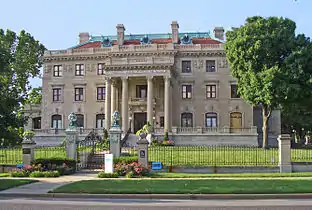Kansas City Museum
The Kansas City Museum is a museum located in Kansas City, Missouri, United States. Housed in a historic 1910 Beaux-Arts style mansion and private estate of lumber baron and civic leader Robert A. Long, the Kansas City Museum became a public museum in 1940. Seventy-five years later, the Museum is under extensive renovation.[2]
R. A. Long House | |
 The Kansas City Museum at Corinthian Hall | |
  | |
| Location | 3218 Gladstone Blvd., Kansas City, Missouri |
|---|---|
| Coordinates | 39.1158°N 94.54241°W |
| Area | 3-acre (12,000 m2) |
| Built | 1909 |
| Architect | Henry Ford Hoit |
| Architectural style | Beaux Arts |
| Website | kansascitymuseum |
| NRHP reference No. | 80002366[1] |
| Added to NRHP | November 14, 1980 |
Background
The 3-acre (12,000 m2) estate consists of Corinthian Hall, named for its Corinthian columns and its outbuildings. Built for Robert A. Long and his family, this private residence was completed in 1910 for an estimated $1 million. It was designed by local architect Henry F. Hoit. Corinthian Hall, the four-story mansion features 35,000-square-foot (3,300 m2) (24,292-square-foot (2,256.8 m2) of livable space)[3] and served as the residence for the Long family until R.A. Long's death in 1934.[4] Daughters Sally and Loula removed decorative items and architectural features from Corinthian Hall (the mansion) for installation in their own homes, and held a two-day auction in late 1934 to sell the remainder of the items in Corinthian Hall. After this auction, the mansion sat empty and was for sale. Very little remained of the original furniture, and in some rooms there was the loss of all architectural fabric. These changes lessened the value of the building as a "historic house". Still, the Longs' daughters donated the estate to the Kansas City Museum Association in 1939. In 1940 it was opened to the public as a history and science museum. Facing financial difficulties, the Museum was deeded to the City of Kansas City, Missouri in 1948.
In the 1950s, display and interpretation of natural history took center stage at the Museum. Early in 1951, taxidermy specimen displays expanded into the basement of Corinthian Hall, along with mineralogical exhibits of fossils, rocks, and minerals.[5] During its heyday in the 1950s and 1960s, the museum housed hundreds of stuffed animals in lifelike dioramas as well as offered various presentations and classes in taxidermy. It featured a 50-seat planetarium, and a 1910-style soda fountain serving phosphates and ice cream.
By the 1970s, museum staff realized that the building was too small to do all it could for local history and science and decided to work toward splitting the Museum. Museum staff and civic leaders looked to the newly empty Union Station as a potential site for a new science museum.
From 2005 until December 2013 the museum was managed by Union Station Kansas City, Inc., the same organization that maintains Kansas City's Union Station,[6][7] In January 2008, the primary buildings of the museum—the residence and carriage house—closed for major renovations[8] of roofing, masonry, art glass, energy efficient windows, elevator, and HVAC.
In May 2014, the City of Kansas City and Missouri's Parks and Recreation Department began to operate and manage the Kansas City Museum.[9]
References
- "National Register Information System". National Register of Historic Places. National Park Service. March 13, 2009.
- Gallagher & Associates (28 April 2017). "Kansas City Museum Visitor Experience Plan": 2. Cite journal requires
|journal=(help) - "3218 Gladstone Blvd". homefacts.com. Retrieved 28 April 2016.
- Bradley, Lenore K. (May 22, 1980). "National Register of Historic Places Inventory Nomination: Long, R.A. Residence" (PDF). National Park Service. Retrieved 2009-05-05.
- "Museum History, From Mansion to Museum".
- Spencer, Laura (May 1, 2014). "A New Era For The Kansas City Museum".
- "Union Station Kansas City, Inc". Propublica. Retrieved April 19, 2020.
- Campbell, Matt (December 20, 2007). "A KC Museum Revamp". Kansas City Star. p. A1:2.
The Kansas City Museum will close on January 7, 2008, and not reopen until 2010 or later.
- Horsley, Lynn (July 4, 2016). "Kansas City Museum is laying out a roadmap for mansion renovation". Kansas City Star.
That phase could be completed in 2019
External links
| Wikimedia Commons has media related to Kansas City Museum. |